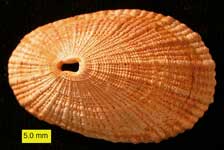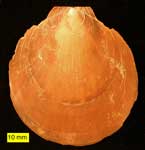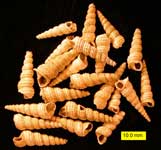| - Art Gallery - |
The Pliocene (English pronunciation: /ˈplaɪəˌsiːn/) Epoch (spelled Pleiocene in older texts) is the period in the geologic timescale that extends from 5.332 million to 2.588[1] million years before present. The Pliocene is the second and youngest epoch of the Neogene Period in the Cenozoic Era. The Pliocene follows the Miocene Epoch and is followed by the Pleistocene Epoch. The Pliocene was named by Sir Charles Lyell. The name comes from the Greek words πλεῖον (pleion, "more") and καινός (kainos, "new") and means roughly "continuation of the recent", referring to the essentially modern marine mollusc faunas. H.W. Fowler called the term (along with other examples such as pleistocene and miocene) a "regrettable barbarism" and an indication that even "a good classical scholar" such as Lyell should have requested a philologist's help when properly coining words.[2] As with other older geologic periods, the geological strata that define the start and end are well identified but the exact dates of the start and end of the epoch are slightly uncertain. The boundaries defining the onset of the Pliocene are not set at an easily identified worldwide event but rather at regional boundaries between the warmer Miocene and the relatively cooler Pliocene. The upper boundary was set at the start of the Pleistocene glaciations.
In the official timescale of the ICS, the Pliocene is subdivided into two stages. From youngest to oldest they are: * Piacenzian (3.600–2.588 Ma) The Piacenzian is sometimes referred to as the Late Pliocene, whereas the Zanclean is referred to as the Early Pliocene. In the system of North American Land Mammal Ages the Pliocene overlaps with two stages: the Blancan (4.75–1.806 Ma) and Hemphillian (9–4.75 Ma). In the system of South American Land Mammal Ages, the Pliocene overlaps with the Montehermosan (6.8-4.0 Ma), Chapadmalalan (4.0-3.0 Ma) and Uquian (3.0-1.2 Ma). In the Paratethys area (central Europe and parts of western Asia) the Pliocene contains the Dacian (roughly equal to the Zanclean) and Romanian (roughly equal to the Piacenzian and Gelasian together) stages. As usual in stratigraphy, there are many other regional and local subdivisions in use. Climate During the Pliocene epoch climate became cooler and drier, and seasonal, similar to modern climates. The global average temperature in the mid-Pliocene (3.3 mya - 3 mya) was 2-3°C higher than today[3], global sea level 25 m higher [4] and Northern hemisphere ice sheet ephemeral before the onset of extensive glaciation over Greenland that occurred in the late Pliocene around 3 Ma.[5] The formation of an Arctic ice cap is signaled by an abrupt shift in oxygen isotope ratios and ice-rafted cobbles in the North Atlantic and North Pacific ocean beds.[6] Mid-latitude glaciation was probably underway before the end of the epoch. The global cooling that occurred during the Pliocene may have spurred on the disappearance of forests and the spread of grasslands and savannas.[7] Paleogeography Continents continued to drift, moving from positions possibly as far as 250 km from their present locations to positions only 70 km from their current locations. South America became linked to North America through the Isthmus of Panama during the Pliocene, making possible the Great American Interchange and bringing a nearly complete end to South America's distinctive large marsupial predator and native ungulate faunas. The formation of the Isthmus had major consequences on global temperatures, since warm equatorial ocean currents were cut off and an Atlantic cooling cycle began, with cold Arctic and Antarctic waters dropping temperatures in the now-isolated Atlantic Ocean. Africa's collision with Europe formed the Mediterranean Sea, cutting off the remnants of the Tethys Ocean. The border between the Miocene and the Pliocene is also the time of the Messinian salinity crisis. Sea level changes exposed the land-bridge between Alaska and Asia. Pliocene marine rocks are well exposed in the Mediterranean, India, and China. Elsewhere, they are exposed largely near shores. Flora The change to a cooler, dry, seasonal climate had considerable impacts on Pliocene vegetation, reducing tropical species worldwide. Deciduous forests proliferated, coniferous forests and tundra covered much of the north, and grasslands spread on all continents (except Antarctica). Tropical forests were limited to a tight band around the equator, and in addition to dry savannahs, deserts appeared in Asia and Africa. Fauna Both marine and continental faunas were essentially modern, although continental faunas were a bit more primitive than today. The first recognizable hominins, the australopithecines, appeared in the Pliocene. The land mass collisions meant great migration and mixing of previously isolated species, such as in the Great American Interchange. Herbivores got bigger, as did specialized predators.
Mammals In North America, rodents, large mastodonts and gomphotheres, and opossums continued successfully, while hoofed animals (ungulates) declined, with camel, deer and horse all seeing populations recede. Rhinos, three toed horses (Nannippus), oreodonts, protoceratids, and chalicotheres went extinct. Borophagine dogs went extinct, but other carnivores including the weasel family diversified, and dogs and fast-running hunting bears did well. Ground sloths, huge glyptodonts, and armadillos came north with the formation of the Isthmus of Panama. In Eurasia rodents did well, while primate distribution declined. Elephants, gomphotheres and stegodonts were successful in Asia, and hyraxes migrated north from Africa. Horse diversity declined, while tapirs and rhinos did fairly well. Cows and antelopes were successful, and some camel species crossed into Asia from North America. Hyenas and early saber-toothed cats appeared, joining other predators including dogs, bears and weasels. Africa was dominated by hoofed animals, and primates continued their evolution, with australopithecines (some of the first hominids) appearing in the late Pliocene. Rodents were successful, and elephant populations increased. Cows and antelopes continued diversification and overtaking pigs in numbers of species. Early giraffes appeared, and camels migrated via Asia from North America. Horses and modern rhinos came onto the scene. Bears, dogs and weasels (originally from North America) joined cats, hyenas and civets as the African predators, forcing hyenas to adapt as specialized scavengers. South America was invaded by North American species for the first time since the Cretaceous, with North American rodents and primates mixing with southern forms. Litopterns and the notoungulates, South American natives, were mostly wiped out, except for the macrauchenids and toxodonts, which managed to survive. Small weasel-like carnivorous mustelids and coatis migrated from the north. Grazing glyptodonts, browsing giant ground sloths and smaller caviomorph rodents, pampatheres, and armadillos did the opposite, migrating to the north and thriving there. The marsupials remained the dominant Australian mammals, with herbivore forms including wombats and kangaroos, and the huge diprotodonts. Carnivorous marsupials continued hunting in the Pliocene, including dasyurids, the dog-like thylacine and cat-like Thylacoleo. The first rodents arrived in Australia. The modern platypus, a monotreme, appeared. Birds The predatory South American phorusrhacids were rare in this time; among the last was Titanis, a large phorusrhacid that migrated to North America and rivaled mammals as top predator. Its distinct feature was its claws, which had re-evolved for grasping prey, such as Hipparion. Other birds probably evolved at this time, some modern, some now extinct. Reptiles Alligators and crocodiles died out in Europe as the climate cooled. Venomous snake genera continued to increase as more rodents and birds evolved. Rattlesnakes first appeared in the Pliocene. The modern species Alligator mississippiensis, having evolved in the Miocene, continued into the Pliocene, except with a more northern range; specimens have been found in very late Miocene deposits of Tennessee. Giant tortoises still thrived in North America, with genera like Hesperotestudo. Madtsoid snakes were still present in Australia. Oceans Oceans continued to be relatively warm during the Pliocene, though they continued cooling. The Arctic ice cap formed, drying the climate and increasing cool shallow currents in the North Atlantic. Deep cold currents flowed from the Antarctic. The formation of the Isthmus of Panama about 3.5 million years ago cut off the final remnant of what was once essentially a circum-equatorial current that had existed since the Cretaceous and the early Cenozoic. This may have contributed to further cooling of the oceans worldwide. The Pliocene seas were alive with sea cows, seals and sea lions. Supernovae In 2002, astronomers discovered that roughly 2 million years ago, around the end of the Pliocene epoch, a group of bright O and B stars called the Scorpius-Centaurus OB association passed within 150 light-years of Earth and that one or more supernovae may have occurred in this group at that time. Such a close explosion could have damaged the Earth's ozone layer and caused the extinction of some ocean life (at its peak, a supernova of this size could have the same absolute magnitude as an entire galaxy of 200 billion stars).[8] See also * List of fossil sites (with link directory)
1. ^ See the 2009 version of the ICS geologic time scale
* Comins, Niel F.; William J. Kaufmann III (2005). Discovering the Universe (7th ed.). New York, NY: Susan Finnemore Brennan. ISBN 0716775840. External links * Mid-Pliocene Global Warming: NASA/GISS Climate Modeling Retrieved from "http://en.wikipedia.org/"
 |
|
|||||||||||


